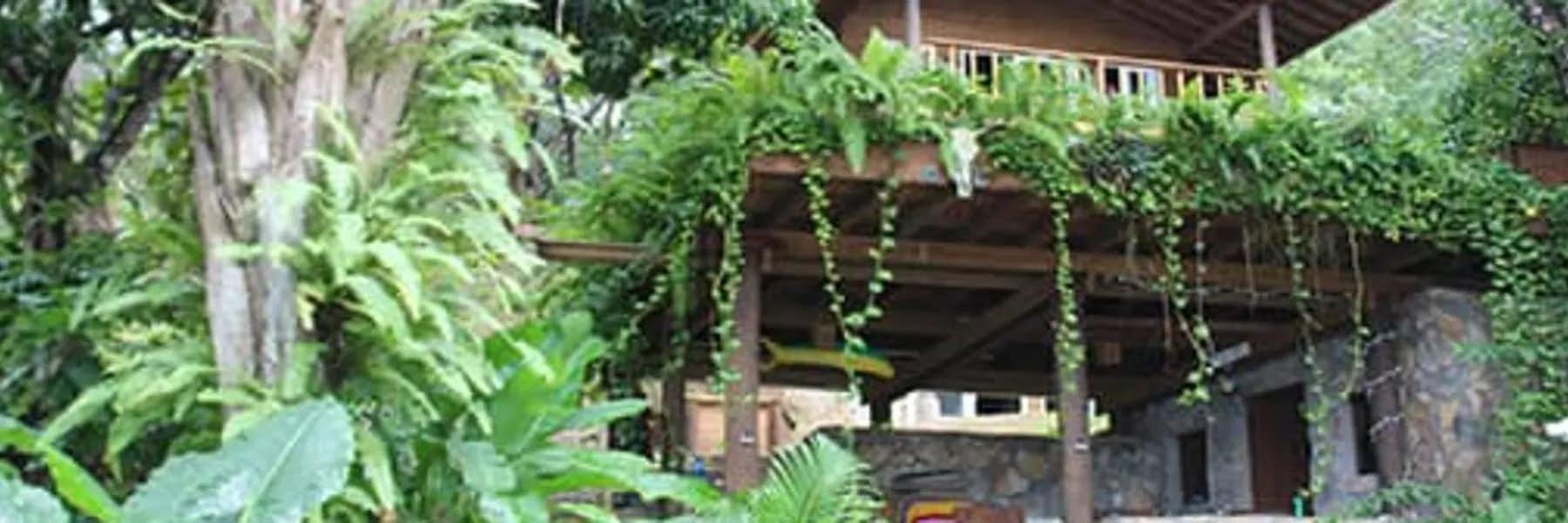It’s a jungle out there! That was our first impression as we headed our small skiff towards the shore in Port Royal, Roatan, on the island’s remote east end. After seven years of living aboard our 38’ Bayliner, Diamond Lil, we were property hunting. Our floating home had allowed us to explore many parts of the island.
The time had come to buy a permanent place and build a home however, our criteria made it a challenge. We needed deep water for our boat and preferably, a dock. We also needed enough property for our horse to graze on, as well as access to riding trails. It was difficult to find all these requirements in one property.
“I know of a piece of property for sale in Port Royal, across from Fort Morgan Cay,” a friend told me when I mentioned our search. “It’s totally off the grid,” she warned. “There are no services—no electricity, no town water, and no garbage pickup. You would be on your own up there. It has been for sale for years so I think you could get it for a good price.”
It was love at first sight. I felt like I had stepped onto a page from a Caribbean Island calendar. A sandy beach stretched along the entire frontage of the 141-foot-wide property. Palm trees dotted the shoreline. The landscape rose from the sea towards the majestic peaks surrounding the bay. The neighboring properties on each side, large and vacant, created a private piece of paradise.
The property, unlike many on the island, had a constant source of freshwater, due to an artesian well and a stream that fed into a cement cistern. A sizeable stand of Ficus trees beyond the stream gave the impression of an enchanted forest. The 2.33 acres of land rendered us practically speechless. I could picture Diamond Lil tied to the existing 90-foot-long dock.
“It won’t be easy,” warned my husband. “Living off the grid means we will have to generate our power and pump water up the steep hill to a storage tank. From there it will gravity feed down to where we will build our house. Building a house here will be a challenge. All our supplies will have to come in by boat.”
“I don’t care,” I pleaded. “I would do anything to live here.” It seemed too good to be true.
But dreams do come true.
Requirements of Living Off the Grid
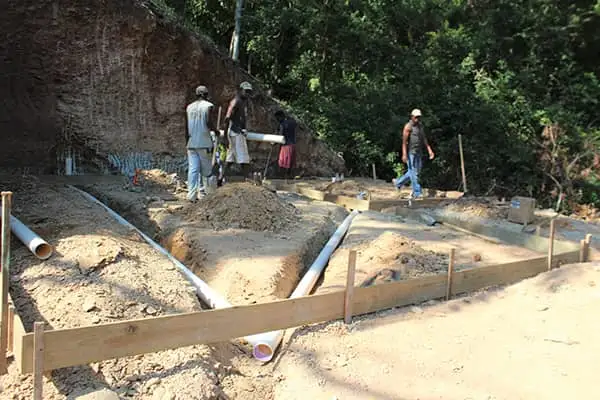
Living off the grid is not for everyone. Important requirements for a successful outcome are a proper mindset and realistic expectations. This is a vastly different lifestyle than what most people in modern-day society are used to. If you are dependent on power-hungry conveniences such as air conditioning, hairdryers, and dishwashers, this way of life, involving hard work and sacrifices, may not be for you. We knew exactly what to expect, having friends who lived off the grid in Port Royal, where we planned to buy. Living successfully on our boat for many years also helped to prepare us.
Another critical requirement for a successful experience is a favorable location. Remote areas without strict permitting regulations are best suited. Closer to large cities or towns, there are more building permit restrictions and building codes to deal with. In many states and countries, it is not legal to unhook from public utilities, making it important to do your research before you buy.
A fresh water collection system, a power generation system, and a waste disposal system are required. Expect start-up costs to put these systems in place, as well as additional costs for property taxes and building permits. In some areas, architects and contractors must be hired. We were fortunate not to need either to build in Roatan, but it is important to do your homework at the planning stage.
Common Mistakes and How to Avoid Them
One man’s dream may be another man’s nightmare. It is important to avoid common mistakes when planning to live off-the-grid. Failure to understand start-up costs is a common error. It is not free to live off-grid. Over time, these costs will be offset by the lack of utility bills, but it is important to research the cost of placing power generation, water collection, and waste disposal systems.
Failure to understand the sacrifices necessary for this lifestyle and the increased physical activity required is another common pitfall. Living in a remote location with limited social contact is not for everyone. It is also critical to remember that one man’s dream may not be the vision of his partner. It is important that both parties have similar expectations.
Building in a remote location presents challenges. Building materials are more difficult to come by and often involve high shipping costs and lengthy waits. Patience is a virtue. Our building project required six years to complete, working five days a week with a crew of between two to five men, depending on the stage we were at. The cost of building permits, inspections, and a contractor’s license came to $1,168.37. Ironically, there was no inspection done before, during, or after construction. We were given the choice of either hiring a contractor or becoming one. For the low cost of $20, my husband was licensed to act as our contractor, with a wallet-sized card to prove it.
Harnessing the Sun
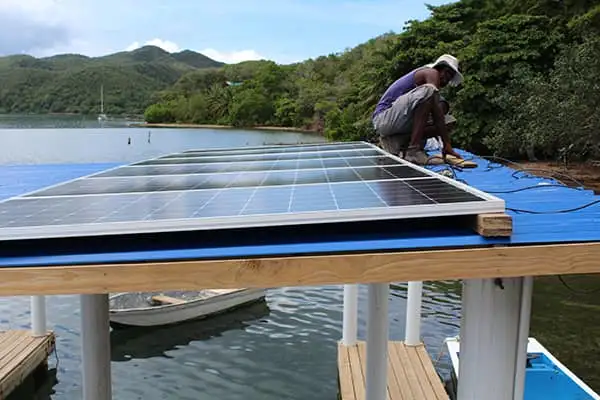
A water access property may sound romantic, however, transporting all building materials by boat would be daunting. Unlike most Port Royal properties, there was a road that led to the top of ours. It was a private, gated road, two miles long, with a bird’s eye view of both the north and south coasts of the island. When the weather was not conducive to boat travel, we could use the road but had to carry our supplies down the steep hillside, 200 feet to the shore below. Empty propane tanks, drinking water jugs, and gas cans had to be hauled up the hill as well. Hiring a backhoe to extend the road down to the building site was a priority.
To build a house, we would need tools. Unless we wanted to spend the rest of our lives building, we would need power tools. That would require power. With no electrical service to Port Royal, a solar system for our property was our first major purchase. We researched our options and decided on a 2,000-watt off-grid system from Sun Electronics in Miami for $4,693 (2016 pricing). We bought 12 deep cycle batteries from DC Batteries, also in Miami, for $3,871.92 (2017 pricing). The total cost to ship the system and batteries from Miami to Roatan was $1,616.05. It was a good start, but we hoped to add another six solar panels to provide more power on overcast days.
The only spot sunny enough to place the panels was at the end of our 90-foot-long dock. A roof over the dock was the perfect place for the panels and also provided shade.
We pumped water from our cistern into a holding tank, which we placed 110 feet up the steep hillside. From there, water was gravity-fed through a series of pipes to various locations throughout the property.
The sun shines most of the time in Roatan but there are cloudy and rainy days, making a generator a necessity. We purchased a 4,000-watt system from Central Marine Diesel in Maine for $1,853.30, including shipping to Miami. The cost to ship it from Miami to Roatan was high, at $600, due to the weight.
Building a Compound Property
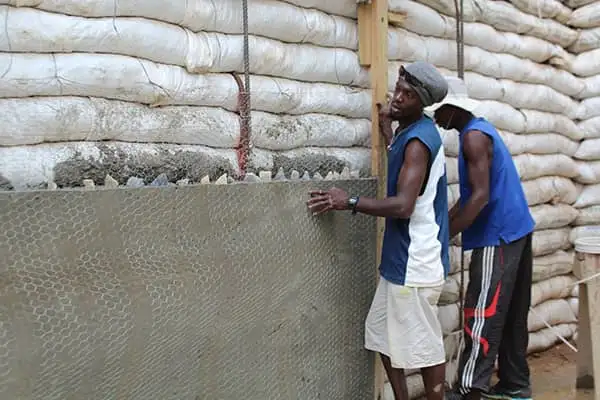
A compound building design is one where separate structures are built for sleeping, cooking, and working. There were two main reasons we built this way. After living on a 38’ boat for seven years, we wanted a little space. The property was unique, with an undulating landscape and hundreds of mature trees, with no large, flat area to build a house.
With no desire to cut and clear, but rather to retain the appealing layout of the land, we planned four separate buildings. First, we built a bodega (shed) for a workshop and to house the solar system, batteries, and the ever-growing inventory of power tools. The second building was a casita (a small house). We used the cement cistern as a foundation, erecting a bumped-out balcony over the top of our bubbling brook. My office and paint studio doubled as a guesthouse when family and friends came to stay. The third building consisted of two stories with our master bedroom and ensuite washroom on the lower level and a guest room with an ensuite bathroom above. Finally, we built the fourth building—the cooking, dining, and living area, including a pantry and powder room.
Earth Bag Construction
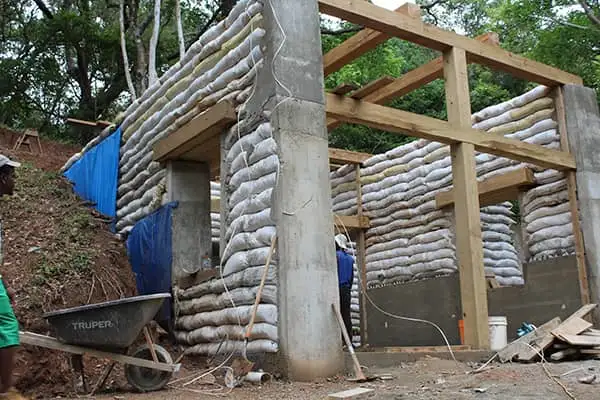
Earthbag construction is an inexpensive and ecologically sound method of building. Polypropene sacks were filled with soil that was removed from the steep hillsides where the buildings would be positioned. The filled sacks were laid out to form walls, placing rebar in corners and beside openings for windows and doors, to add strength to the structure.
Barbed wire was laid between rows to keep the bags in place and pieces of twine were added between the rows. Once the walls reached the specified height, we fastened chicken wire to the wall, securing it with the twine that had been laid between the bags. Finally, a coating of cement was applied to the chicken wire. The outer walls were faced with attractive island stone. Inside the house, we painted the cement.
A Living Roof

We designed our buildings with large roof overhangs, to provide shade from the sun and protection from the rain, so we could enjoy the outdoors in all weather. Due to the steep terrain, the view from these buildings was the bodega roof. It was not an attractive sight, however the flat, gently sloping design, was perfect for a living roof. A large tarpaulin was laid on top of a sturdy wooden base and then covered with topsoil and sod. Planters built around the edges provided a safe place for ferns and tropical plants, without fear of roots penetrating the roof below. Flowing vines cascaded over the edges, creating a dense curtain of tropical foliage.
The Pay Off
After six years of hard work, we can now enjoy the benefits of living off-the-grid. There is nowhere we would rather spend our golden years than Port Royal, Roatan. With power outages common on the island, we are thrilled to be independent. I calculated, based on an average electricity bill alone, that our solar system, including the generator, paid for itself in five years. The only regular bill we have now is for the internet.
Another day in paradise draws to an end. The horses, chickens, ducks, cats, and dogs have been fed. It’s happy hour and we can be found, not in front of a television set inside our house, but outside, in front of our daily bonfire. We lounge in chairs that Joh built himself. He has gathered wood from the never-ending supply of fallen limbs in the woodlot beside us. The sounds we hear are of the crackling fire, the waves lapping against our shoreline, and a flock of wild, yellow-naped parrots flying overhead. Life is golden!
Related Articles
Retire in Honduras to Enjoy an Enviable Retirement Lifestyle
